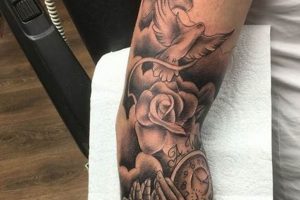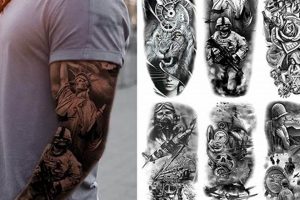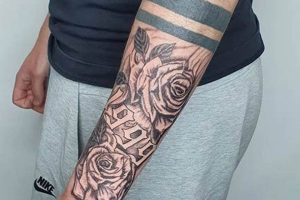A full or half-arm tattoo, encompassing a cohesive artistic theme, often employs vibrant pigments to achieve striking visual effects. Examples include nature scenes, abstract patterns, portraits, and depictions of cultural or personal symbolism, brought to life through a skilled artist’s use of color.
Planning extensive arm tattoos allows for complex and personalized narratives expressed through body art. The canvas size permits detailed designs and the strategic application of color enhances emotional impact and visual depth. Historically, extensive tattooing held cultural significance, representing status, beliefs, or group affiliation. While contemporary applications often prioritize aesthetic expression, the tradition of imbuing tattoos with personal meaning persists.
The following sections will explore diverse aesthetic styles, discuss practical considerations such as color palettes and placement, and provide guidance for collaborating effectively with tattoo artists to realize impactful, personalized designs.
Tips for Planning a Color Tattoo Sleeve
Careful planning is crucial for a successful color tattoo sleeve. These tips offer guidance for navigating the process.
Tip 1: Research Tattoo Styles: Explore various styles, such as realism, traditional, Japanese, or watercolor, to determine which best suits the desired aesthetic and subject matter. Gathering reference images aids in visualizing the final result.
Tip 2: Consider Color Palette: Color selection significantly impacts the overall effect. Analyze how different hues complement each other and the skin tone. Account for potential fading over time, especially with lighter shades.
Tip 3: Plan for Placement and Flow: The arm’s anatomy influences how the design wraps around it. A skilled artist can create a cohesive composition that complements the body’s natural contours.
Tip 4: Choose an Experienced Artist: Seek an artist specializing in the chosen style and with a strong portfolio of color work. Consultations are essential for discussing ideas and ensuring artistic compatibility.
Tip 5: Prepare for Multiple Sessions: Complex designs require multiple sessions to complete. Factor this into scheduling and budget planning. Proper aftercare between sessions is vital for optimal healing and color vibrancy.
Tip 6: Think Long-Term: Tattoos are a permanent commitment. Thorough consideration of design choices ensures lasting satisfaction. Evaluate how the chosen imagery might evolve in meaning over time.
Tip 7: Budget Accordingly: High-quality, large-scale color tattoos represent a significant investment. Obtain clear pricing information upfront to avoid unexpected expenses.
By following these guidelines, individuals can approach the process informed and prepared, resulting in a beautiful, well-executed, and personally meaningful piece of body art.
This careful preparation ultimately contributes to a rewarding experience and a visually stunning, long-lasting result.
1. Theme
Thematic coherence is paramount in successful color tattoo sleeve designs. A well-defined theme provides a narrative framework, unifying disparate elements into a cohesive and meaningful whole. This framework guides artistic choices, ensuring a harmonious blend of imagery, color palette, and overall composition.
- Nature
Nature-inspired themes offer vast possibilities. Floral motifs, animal portraits, depictions of landscapes or celestial bodies can evoke feelings of tranquility, power, or connection to the natural world. For instance, a sleeve depicting a forest scene might utilize earthy greens and browns, accented with vibrant colors of flora and fauna, creating a visually rich and symbolic representation of growth and renewal.
- Cultural Heritage
Tattoos can serve as powerful expressions of cultural identity. Themes referencing mythology, folklore, or traditional artistic styles allow individuals to connect with their heritage visually. A sleeve inspired by Japanese woodblock prints, for instance, could incorporate bold lines, vibrant colors, and iconic imagery like dragons or samurai, creating a striking tribute to a specific cultural aesthetic.
- Abstract Concepts
Abstract themes offer a canvas for personal expression. Geometric patterns, surreal imagery, or representations of emotions or ideas can be woven together to create unique and thought-provoking designs. A sleeve exploring the concept of time, for example, might utilize swirling patterns, clockwork gears, and a shifting color gradient to symbolize the passage and fluidity of time.
- Personal Narrative
A sleeve can tell a personal story, visually representing significant life events, relationships, or passions. Incorporating symbolic imagery, meaningful quotes, or portraits of loved ones allows individuals to externalize and celebrate their unique experiences. A sleeve dedicated to a musical passion, for instance, could feature instruments, musical notes, and portraits of influential musicians, creating a vibrant and personalized tribute.
The chosen theme serves as the foundation upon which the entire sleeve design is built. Careful consideration of thematic resonance ensures that the final artwork not only visually captivates but also holds deep personal meaning for the wearer, transforming the skin into a canvas for storytelling and self-expression.
2. Color Palette
Color palettes are fundamental to the aesthetic impact of a tattoo sleeve. Strategic color selection significantly influences the overall mood, visual depth, and longevity of the design. Careful consideration of color theory principles, skin tone, and desired aesthetic is crucial for a successful outcome.
- Complementary Colors
Employing complementary colorsthose opposite each other on the color wheelcreates vibrant contrast and visual interest. For example, pairing orange with blue or red with green can result in a dynamic and eye-catching design. However, excessive use of highly saturated complementary colors can appear jarring; careful balancing is essential.
- Analogous Colors
Analogous color palettes utilize hues adjacent to each other on the color wheel, fostering a sense of harmony and visual cohesion. A sleeve employing shades of green, blue, and teal, for instance, evokes a calming, naturalistic aesthetic. This approach creates a smoother transition between colors and a less dramatic, more unified look.
- Monochromatic Palettes
Monochromatic palettes explore variations in shade and tint within a single color family. A black and grey sleeve, for example, relies on subtle shifts in value to create depth and visual interest. This approach can result in a sophisticated and elegant aesthetic, focusing on intricate details and shading rather than vibrant color contrasts.
- Skin Tone Considerations
Skin tone plays a significant role in color selection. Certain colors appear more vibrant on specific skin tones. For example, warmer colors often complement darker skin tones, while cooler colors may be more suitable for lighter complexions. An experienced tattoo artist can provide guidance on selecting colors that will best complement an individual’s skin tone and ensure optimal visibility and impact.
Ultimately, the chosen color palette contributes significantly to the overall aesthetic impact and longevity of the tattoo sleeve. A well-planned palette enhances the chosen theme, complements the wearer’s skin tone, and ensures the design remains visually appealing over time. Consultation with a skilled tattoo artist is invaluable in navigating these complexities and achieving the desired outcome.
3. Placement
Placement is integral to the overall impact of a color tattoo sleeve. The arm’s natural contours and musculature influence how the design flows and interacts with the body. Strategic placement enhances the visual narrative and ensures the artwork complements the wearer’s physique. Consideration of visibility, movement, and the interplay of different design elements is essential. A design incorporating a dragon, for example, might wrap around the shoulder and bicep, emphasizing the arm’s curves and creating a sense of dynamic movement. Alternatively, a floral design might flow along the forearm, mirroring its natural lines.
Different areas of the arm offer distinct canvases, each influencing the perceived scale and impact of design elements. The inner arm, often chosen for more personal or intimate imagery, presents a relatively flat surface suitable for detailed work. The outer arm, typically more visible, provides a larger canvas for bolder designs and more vibrant color displays. Understanding these nuances allows for strategic placement of key elements, maximizing their visual impact. Placement choices also affect how the tattoo interacts with clothing, either partially concealing or fully revealing the artwork depending on sleeve length and design placement.
Effective placement harmonizes the tattoo with the body’s form, maximizing aesthetic impact and enhancing the narrative flow of the design. The interplay between placement, color, and design elements creates a cohesive and dynamic artwork that complements the wearer’s physique. Careful consideration of these factors, in consultation with a skilled tattoo artist, ensures a successful and visually stunning result. Ignoring these considerations can result in a disjointed or awkward appearance, detracting from the overall artistry and intended message of the tattoo.
4. Style
Style significantly impacts the aesthetic and expressive qualities of color tattoo sleeves. Distinct styles possess unique characteristics influencing color palettes, linework, and overall composition. Selecting a style congruent with the intended theme and personal aesthetic is crucial for a cohesive and impactful result. For example, a Japanese-style sleeve might employ bold lines, vibrant colors, and traditional imagery like dragons or koi fish, while a watercolor-style sleeve might feature softer, blended colors and more abstract or painterly imagery.
Understanding stylistic nuances informs design choices and facilitates effective communication with tattoo artists. Realism emphasizes accurate depiction of subjects, often employing a wide range of colors and intricate shading. Traditional styles prioritize bold outlines and a limited color palette, focusing on iconic imagery and symbolic representation. Geometric styles utilize precise lines and shapes, often incorporating abstract patterns and color blocking techniques. The interplay between style and color palette contributes significantly to the overall mood and message conveyed by the tattoo. Choosing a style aligned with personal preferences ensures a result that resonates with the wearer’s individual expression.
Careful consideration of style is essential for a successful color tattoo sleeve. Style dictates the visual language of the tattoo, influencing its emotional impact and long-term aesthetic appeal. A thorough understanding of different styles empowers informed decisions, fostering a collaborative process with the artist and ensuring the final product reflects the wearer’s vision and personal style. Failure to consider style can result in a disjointed or aesthetically unsatisfying outcome, highlighting the practical significance of this understanding within the broader context of color tattoo sleeve design.
5. Artist Selection
Artist selection is paramount when realizing complex color tattoo sleeve concepts. A skilled artist translates ideas into visually compelling and technically sound artwork. Expertise in color theory, skin tone interaction, and stylistic nuances significantly impacts the final result. An artist specializing in realism, for example, possesses a different skill set than one specializing in traditional Japanese tattooing. Choosing an artist whose style aligns with the desired aesthetic ensures the vision is effectively translated onto skin. Portfolio review is essential; examining previous work reveals an artist’s proficiency with color blending, saturation, and composition within a specific style. This careful selection process minimizes the risk of misinterpretation or unsatisfactory execution, particularly crucial for large-scale projects like sleeves.
Effective communication between artist and client is facilitated by shared aesthetic sensibilities. Discussing color palettes, imagery, and placement preferences allows the artist to tailor the design to individual needs and ensure a collaborative approach. An artist specializing in biomechanical designs, for example, might offer valuable insights into incorporating vibrant colors and intricate details specific to that style. Furthermore, an experienced artist provides guidance on practical considerations like skin preparation, aftercare procedures, and long-term color maintenance, essential for preserving the vibrancy and integrity of the artwork over time. This collaborative dynamic maximizes the likelihood of a successful outcome, transforming abstract concepts into tangible, personalized works of art.
Investing time in artist selection mitigates potential complications and ensures artistic vision is realized effectively. Technical proficiency, stylistic compatibility, and open communication contribute significantly to the overall success of a color tattoo sleeve project. This informed decision-making process protects against aesthetic disappointment and ensures a rewarding collaborative experience, resulting in a high-quality, personally meaningful piece of body art. Ultimately, the artist’s skill and understanding of color significantly influence the longevity and visual impact of the design, emphasizing the critical role artist selection plays in realizing a successful and enduring color tattoo sleeve.
6. Longevity
Longevity is a critical factor in color tattoo sleeve design. Preserving the vibrancy and clarity of the artwork over time requires understanding ink properties, aftercare practices, and the impact of environmental factors. Proper planning and maintenance are essential for ensuring a visually appealing tattoo that endures for years to come. Neglecting these considerations can lead to premature fading, color distortion, and a compromised aesthetic.
- Ink Quality
High-quality tattoo inks, specifically formulated for color saturation and longevity, are crucial. These inks contain finer pigments that resist breakdown and fading over time. Inferior inks may contain impurities or larger pigment particles that are more susceptible to fading or discoloration, particularly when exposed to sunlight or environmental pollutants. Choosing professional-grade inks is an investment in the long-term vibrancy of the tattoo.
- UV Exposure
Sunlight is a primary factor in tattoo fading. Ultraviolet (UV) radiation breaks down ink pigments, causing colors to lose vibrancy and definition. Protecting tattoos from prolonged sun exposure, using high-SPF sunscreen, and choosing appropriate clothing coverage are crucial for preserving color saturation, especially for vibrant colors like reds and yellows, which are more susceptible to fading. Regular application of sunscreen is a crucial long-term maintenance practice.
- Aftercare Practices
Proper aftercare significantly impacts tattoo longevity. Following the artist’s instructions regarding cleaning, moisturizing, and protecting the tattoo during the healing process is crucial. Avoiding harsh soaps, excessive scrubbing, and exposure to contaminated water minimizes the risk of infection and promotes optimal healing, which in turn supports color retention. Consistent adherence to aftercare protocols is essential for preserving the tattoo’s integrity and vibrancy.
- Color Selection
Certain colors are inherently more prone to fading than others. Lighter colors, such as pastels and yellows, tend to fade more quickly than darker, more saturated colors. Understanding these tendencies informs color selection and allows for strategic placement of more fade-resistant colors in prominent areas of the design. Consulting with an experienced artist helps in choosing a color palette that balances aesthetic preferences with long-term vibrancy considerations.
These factors significantly influence the long-term aesthetic appeal of a color tattoo sleeve. Addressing each element proactively, through informed choices and consistent maintenance practices, ensures the artwork remains vibrant and visually impactful for years. A well-maintained tattoo demonstrates respect for the artistry and personal significance embodied in the design, underscoring the importance of longevity considerations within the broader context of color tattoo sleeve planning and execution.
Frequently Asked Questions
Addressing common inquiries regarding color tattoo sleeves provides clarity and facilitates informed decision-making. The following addresses key considerations for individuals contemplating this form of body art.
Question 1: How much does a color tattoo sleeve typically cost?
Cost varies significantly based on factors like artist experience, design complexity, size, and geographic location. Obtaining quotes from multiple reputable artists is recommended.
Question 2: How long does a color tattoo sleeve take to complete?
Completion time depends on design intricacy and individual pain tolerance. Complex sleeves often require multiple sessions, each lasting several hours, spaced weeks apart for healing.
Question 3: Does a color tattoo sleeve hurt more than a black and grey sleeve?
Pain levels are subjective. Color tattooing might require multiple passes with the needle to achieve desired saturation, potentially increasing discomfort slightly. However, pain perception varies considerably among individuals.
Question 4: How does one choose the right tattoo artist for a color sleeve?
Reviewing artist portfolios, seeking recommendations, and scheduling consultations are crucial. Focus should be placed on artists specializing in the desired style with demonstrated expertise in color application.
Question 5: What are the key aftercare procedures for a color tattoo sleeve?
Following the artist’s aftercare instructions diligently is essential. This typically involves keeping the tattoo clean, moisturized, and protected from sun exposure during the healing process.
Question 6: Can color tattoos be removed or lightened?
Laser removal can lighten or remove color tattoos, although complete removal is not always guaranteed, particularly with certain colors. Multiple sessions are often required, and the process can be expensive and time-consuming.
Thorough research and consultation with experienced professionals are crucial for navigating the complexities of color tattoo sleeve design and ensuring a satisfying, long-lasting result. Informed decision-making minimizes potential risks and maximizes the likelihood of realizing one’s artistic vision effectively.
This concludes the frequently asked questions section. The following section will delve into (Continue with the next section of your article)
Conclusion
Comprehensive planning is crucial for successful color tattoo sleeve realization. Careful consideration of thematic coherence, strategic color palette selection, informed placement choices, appropriate style identification, diligent artist selection, and proactive longevity planning ensures impactful, enduring artwork. Each element contributes significantly to the overall aesthetic and personal significance of the tattoo.
A color tattoo sleeve represents a significant commitment, transforming skin into a canvas for personal expression. Thorough preparation, informed decision-making, and a collaborative approach with a skilled artist maximize the potential for a visually stunning and deeply meaningful result, one that resonates with the wearer for years to come. Ultimately, the fusion of artistic vision and technical expertise transforms abstract concepts into enduring works of art.







